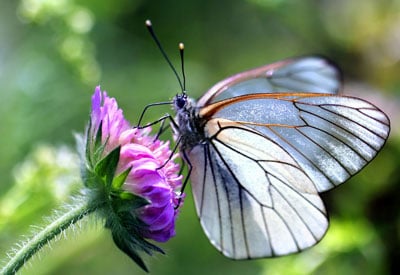Butterfly Gardening: Plants, Design and Tips

A butterfly garden is a haven that provides nectar for adult butterflies and host plants for caterpillars. This enchantingly beautiful garden is not only visually appealing but also plays a significant role in supporting the life cycles of different butterfly species.
The charm of butterfly gardens lies in their ability to attract a variety of fluttery guests, including butterflies, hummingbirds, and even beneficial insects.
Creating a butterfly garden involves the careful selection of perennials, shrubs, and herbs that bloom at different times of the year. This ensures a consistent supply of nectar, which is crucial for adult butterflies.
Key plants to consider include milkweed, asters, lantana, pentas, butterfly bush, and zinnia. These plants not only provide nectar but also serve as host plants where butterflies can lay their eggs.
In butterfly gardens, it’s important to avoid the use of pesticides, as these can harm both the adult butterflies and the butterfly larvae. In fact, even Bacillus thuringiensis (BT) is harmful against caterpillars and is not recommended.
In this article, as a master gardener, I’ll go over everything you need to know to establish a butterfly garden effectively and easily.
What is Butterfly Gardening?
Butterfly gardening is a horticultural practice designed to attract and nurture butterflies within a specific environment. This type of gardening not only enhances the aesthetic appeal of your outdoor space but also contributes to the conservation of these beautiful creatures.

Close up photo of a brown and green butterfly sitting on an orange flower a greenhouse
The concept of butterfly gardening is based on understanding the lifecycle and habitat preferences of butterflies. The lifecycle of a butterfly consists of four stages: egg, larva (caterpillar), pupa (chrysalis), and adult. Each stage requires a different set of resources for survival and growth.
In butterfly gardening, the gardener creates a habitat that provides these resources. This includes planting specific types of plants that serve as food for caterpillars and nectar sources for adult butterflies. The garden should also provide shelter, water, and sunning spots for butterflies.
Butterfly gardening is not just about planting flowers. It’s about fostering an ecosystem that supports all stages of a butterfly’s life. This involves careful planning and knowledge about the types of butterflies native to your area and the plants they prefer.
How to Create a Butterfly Garden
Designating a portion of your garden to attract and nurture butterflies is a rewarding endeavor. Not only do butterflies add beauty and interest to your outdoor space, but they also play a crucial role in pollination.
Here’s how you can transform your garden into a butterfly haven.
1. Consider Planting Butterfly-Friendly Flowers


When planning a butterfly garden, the first step is to consider planting butterfly-friendly flowers. These are plants that not only attract butterflies with their vibrant colors and fragrant scents but also provide necessary sustenance for these beautiful creatures.
Perennials
Perennials are the backbone of any successful butterfly garden. These plants, which return year after year, provide a consistent source of nectar for butterflies and caterpillars.


Unlike annuals, which complete their life cycle in a single growing season, perennials live for several years, offering a reliable food source and habitat for butterflies.
When selecting perennials for your butterfly garden, it’s essential to choose a variety of plants that bloom at different times throughout the growing season.
This ensures that your garden provides a continuous supply of nectar. Some popular perennial choices for butterfly gardens include milkweed, coneflowers, and black-eyed Susans.
In addition to providing nectar, many perennials also serve as host plants for caterpillars. For instance, milkweed is the only plant that Monarch caterpillars can eat, making it an essential addition to any butterfly garden.
Remember, the key to a successful butterfly garden is diversity. By incorporating a wide range of perennials, you can attract a variety of butterfly species and provide a habitat that supports their life cycle from caterpillar to butterfly.
Flowering Shrubs
Flowering shrubs are an essential component of butterfly gardens. They not only add structure and beauty to the garden but also serve as a source of nectar for adult butterflies and hummingbirds.
Plus, some shrubs can act as host plants for different species of caterpillars, providing a place for butterflies to lay their eggs and for the butterfly larvae to feed and grow.
One popular choice for butterfly gardens is the butterfly bush. This perennial shrub, as its name suggests, is a magnet for different butterfly species. It blooms in late summer, offering a rich source of nectar when many other plants have finished blooming.
However, it’s important to note that while butterfly bush is attractive to adult butterflies, it does not serve as a host plant for any species of caterpillars.
Viburnum is another excellent choice for butterfly gardens. This shrub offers both nectar for adult butterflies and leaves for caterpillars. Some species of Viburnum, such as the Blackhaw Viburnum, are native to Texas and are well adapted to its climate and soil conditions.


Other flowering shrubs that are beneficial to butterflies include lantana, pentas, and zinnia. These plants are not only beautiful but also provide a continuous supply of nectar throughout the growing season. Lantana and pentas are particularly attractive to butterflies and hummingbirds.
Nectar-Rich Flowers
Nectar-rich flowers are an essential component of any butterfly garden. These flowers serve as a primary food source for adult butterflies, providing them with the necessary energy to fly, mate, and lay eggs. The nectar from these flowers is rich in sugars and other nutrients, making it a vital part of the butterfly’s diet.
When selecting nectar-rich flowers for your butterfly garden, it’s important to consider a few factors. First of all, aim for a variety of flowers that bloom at different times throughout the year. This will ensure a continuous supply of nectar for the butterflies, attracting them to your garden across all seasons.
Plus, opt for native flowers. Butterflies are more likely to be attracted to and benefit from the nectar of native plants with which they have co-evolved. Native flowers are also more likely to be hardy and require less maintenance, making them a practical choice for your garden.
Also, consider the color and shape of the flowers. Butterflies are particularly attracted to bright colors such as red, yellow, pink, and purple. They also prefer flat-topped or clustered flowers that provide a landing platform.


Some examples of nectar-rich flowers that are popular among butterflies include milkweed, zinnias, sunflowers, and butterfly bush. These plants not only provide a valuable food source for butterflies but also add beauty and color to your garden.
2. Have Flowers with Varying Heights
When planning your butterfly garden, it’s important to consider the heights of your plants. Having flowers of varying heights can significantly enhance the overall appeal of your garden, while also providing a more conducive environment for butterflies.
Butterflies are attracted to a variety of flowers, and they tend to prefer those that are at different levels. This is because different species of butterflies have different preferences when it comes to the height of the flowers they feed on. Some species prefer low-growing flowers, while others are attracted to those that are higher up.
Incorporating plants of varying heights into your butterfly garden can also provide the butterflies with more options for shelter and breeding. Tall plants can offer a safe haven from predators, while shorter plants can provide a suitable place for butterflies to lay their eggs.
When selecting plants for your butterfly garden, consider a mix of ground cover plants, medium-height flowers, and taller shrubs or trees. This will not only give your garden a more layered and dynamic look, but it will also make it more attractive to a wider range of butterfly species.


Ground cover plants such as sweet alyssum and phlox provide a low level of flowering plants for butterflies. Medium-height flowers like butterfly bush and coneflowers can serve as the main attraction for butterflies. Meanwhile, taller plants like lilacs and buddleia can provide a backdrop to your garden and a high perch for butterflies.
3. Add Plants for Butterfly Caterpillars
To attract a variety of butterfly species to your garden, it is essential to incorporate a range of different plants that cater to the needs of both adult butterflies and their larvae.
The butterfly life cycle involves four stages: egg, caterpillar (larvae), pupa (cocoon), and adult. Each stage requires specific plants for survival.
Butterflies lay their eggs on what are known as host plants. These plants provide the necessary food for the emerging caterpillars. Different butterfly species lay their eggs on different host plants. For instance, the Monarch butterfly lays its eggs on milkweed, the only plant its caterpillars can eat.
When selecting plants for your butterfly garden, consider including a variety of perennials, shrubs, and herbs that serve as host plants. Dill, for example, is a host plant for the Black Swallowtail butterfly. Other herbs, such as parsley and fennel, also attract this species of caterpillars.


Willow, cherry, and plum trees are host plants for several butterfly species, including the Red-spotted Purple and the Viceroy. If you have space, these trees can make a beautiful and beneficial addition to your butterfly garden.
In addition to host plants, it’s also important to include nectar-rich plants for adult butterflies. Perennials like asters, daisies, and zinnias bloom in late summer and provide a valuable food source for butterflies. Shrubs such as butterfly bush, lantana, and viburnum are also excellent choices.
4. Choose a Sunny Location
Choosing the right location for your butterfly garden is crucial for its success. Butterflies are cold-blooded creatures, which means they rely on the environment to regulate their body temperature. They need the sun to warm their bodies for flight. Therefore, a sunny location is ideal for a butterfly garden.
The majority of plants that attract butterflies also require full sun exposure to thrive. Full sun exposure means the area receives at least six hours of direct sunlight each day. When selecting a location for your butterfly garden, consider the sun’s path throughout the day. The site should not be shaded by buildings or trees during peak sun hours.


In addition to sunlight, butterflies also need protection from strong winds. Wind can make it difficult for butterflies to feed and lay eggs. Therefore, if the chosen location is exposed to strong winds, consider adding a windbreak. This could be a fence, a row of shrubs, or a garden wall.
5. Set Up Shelter Areas
Butterflies are delicate creatures that require specific conditions to thrive. One of the most crucial aspects of a successful butterfly garden is providing adequate shelter areas.
These areas serve multiple purposes, including protection from predators, harsh weather conditions, and a place for butterflies to rest and breed.
The first step in setting up butterfly shelter areas is to understand the types of shelters butterflies prefer. Butterflies are generally attracted to areas that offer a mix of sunlight and shade.
They need the sun to warm their bodies for flight, but also require shaded areas to protect them from overheating. Therefore, strategically placing your plants to provide both sun and shade is essential.
Another important factor to consider is the structure of the shelter. Butterflies prefer areas that are protected from the wind. This can be achieved by using dense shrubs or trees to form a windbreak.
Plus, butterflies need places to roost at night and during bad weather. Providing flat stones or logs in a shelter area gives butterflies a place to rest.
6. Offer Alternative Butterfly Foods
While nectar from blooming flowers is the primary food source for adult butterflies, they also benefit from alternative food sources.
Offering a variety of butterfly foods not only attracts a wider range of species to your garden but also ensures that they receive a balanced diet, contributing to their overall health and longevity.
One alternative food source is ripe fruit. Butterflies are particularly fond of sweet, overripe fruits such as bananas, oranges, and watermelons.


You can simply place the fruit in a shallow dish and position it in a quiet, sunny spot in your garden. Be sure to replace the fruit once it starts to mold.
Another alternative is a homemade butterfly feeder filled with a sugar solution. To make this, dissolve one part granulated sugar in four parts water. Boil the mixture for a few minutes until the sugar is completely dissolved, then let it cool. Fill a shallow dish or sponge with the solution and place it in your garden. The sweet liquid will attract butterflies, providing them with a valuable energy source.
Butterflies also need minerals and salts, which they usually get from damp soil. To provide this, you can make a butterfly puddling station. Fill a shallow dish with sand, add a pinch of table salt or a bit of compost or manure, and keep the sand damp.
Male butterflies, in particular, will flock to these puddling stations to absorb the salts and amino acids they need for successful mating.
7. Provide Butterfly Puddling Stations
Butterflies are not only attracted to the vibrant colors and sweet nectar of flowers, but they also require other sources of nutrients for their survival and reproduction. One such source is a puddling station.
Puddling is a behavior exhibited by butterflies, particularly males, in which they gather on wet sand, mud, or soil to drink water and extract minerals. These minerals, such as salts and amino acids, are essential for their reproduction.


To provide a puddling station in your butterfly garden, you can simply fill a shallow dish or container with a mixture of sand and water. You can also add a pinch of table salt or a bit of compost to enrich the mixture with minerals. Make sure to keep the sand moist at all times.
Position the puddling station in a sunny spot, preferably near the nectar-rich flowers. This will allow the butterflies to easily find the station while they are foraging for food.
Remember, the goal is to mimic the natural habitats of butterflies as closely as possible. Providing a puddling station is a simple yet effective way to attract more butterflies to your garden and ensure they have everything they need to thrive.
8. Avoid Pesticides That Harm Butterflies
In the pursuit of maintaining a vibrant and healthy butterfly garden, it is crucial to avoid the use of harmful pesticides. Pesticides, while effective in eliminating unwanted pests, can also be detrimental to the life cycles of butterflies, from the eggs to the adult butterflies.
Pesticides, particularly those that are broad-spectrum, can be highly toxic to butterflies. They not only kill off the adult butterflies but can also have detrimental effects on the larvae and eggs. This can significantly reduce the butterfly population in your garden, thereby affecting the overall health and aesthetic appeal of your garden.
Instead of using harmful pesticides, consider adopting more butterfly-friendly pest control methods. One such method is the use of biological controls, such as beneficial insects that prey on harmful pests.
Ladybugs, spiders, and certain types of wasps are natural predators of many garden pests and pose no threat to butterflies.


Another effective method is the use of organic or natural pesticides. These are derived from plants and minerals and are less harmful to butterflies. However, they should still be used sparingly and only as a last resort.
Plus, practicing good garden hygiene can also help keep pest populations in check. Regularly remove dead leaves and other garden debris, as these can often harbor pests. Also, ensure your plants are healthy, as strong, vigorous plants are less likely to be attacked by pests.



